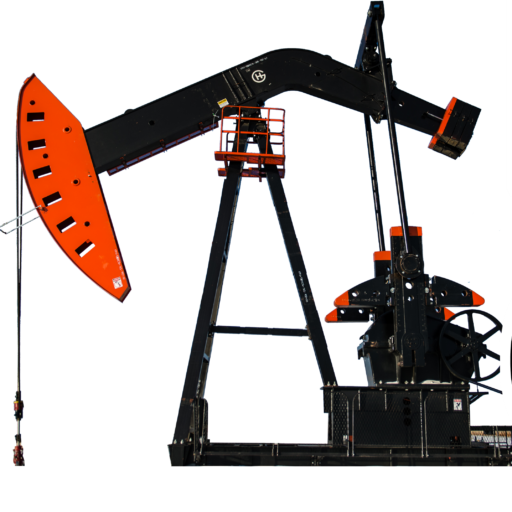An op-ed, short for “opposite the editorial page”, is a written prose piece, which expresses the opinion of an author usually not affiliated with the publication’s editorial board.
Editor’s Note: Kaase Gbakon is a Prince Albert-based economist.
KEY TAKEAWAYS
- A key benefit highlighted by the TMX is that it would help narrow the discount experienced by the heavy Alberta crude oil relative to WTI and Brent benchmark and help Alberta’s crude find homes in China and rest of Asia.
- The WCS, produced in Alberta, is a special blend of about 20 different conventional and unconventional oil crudes created in 2004. It is classified as “heavy crude” with 20.9°API density.
- Based on annual averages, WCS discount with respect to WTI has ranged from $11/bbl to $34/bbl.
- If the operation of Trans Mountain pipeline could cause the price of WCS to increase by $1/bbl (or the discount to WTI shrink by $1/bbl), then Alberta could receive C$680 million more in oil royalty revenue – all else equal.
INTRODUCTION
The twinning of the existing 1,150km Trans Mountain pipeline (called the Trans Mountain Expansion project – TMX) between Strathcona County, Alberta, and Burnaby, British Columbia, in Canada was just recently completed to great fanfare. TMX is designed to add 590,000 Bbls/day from Western Canada with the implication that Alberta’s total pipeline export capacity will increase to about 5.17 MMbpd.
The TMX project came in 7-times over budget at a cost of $34 billion and was 12 years late. So, what was all the confetti in the air for?
- It promises to deliver Alberta crude to more markets than just the United States by providing access to tidewater.
- It would help narrow the discount experienced by the heavy Alberta crude oil relative to WTI and Brent benchmark and thus more money to government and companies.
- It helps reinforce Canada’s place on the world scene as a serious energy player and reliable partner to her allies.
- Create thousands of good paying jobs.
With the pipeline operational, the price discount between light and heavy crudes is expected to reduce significantly. However, 3-months later, keen watchers already complain that the promised discount is yet to materialize.
Nevertheless, in this article we examine the moving parts behind the expectation that TMX would narrow the WCS – WTI discount, and thus cause a bump in the revenue receipts to the good people of Wild Rose country.
Let’s go!
- 0110 SaskEnergy SEI_Network_Members_Burn_Brighter0110 SaskEnergy SEI_Network_Members_Burn_Brighter
- 0109 SaskPower SASPO_2817_PLT_Recruitment_DIVERSITY0109 SaskPower SASPO_2817_PLT_Recruitment_DIVERSITY
- 0106 SASPO-2874_Self Serve Campaign_New Connects_Youtube_v30106 SASPO-2874_Self Serve Campaign_New Connects_Youtube_v3
- 0105 SaskEnergy Commitment to Safety0105 SaskEnergy Commitment to Safety
- 0102 Lori Carr Coal Extended0102 Lori Carr Coal Extended
- 0100 Turnbull Project Manager0100 Turnbull Project Manager
- 0099 Mryglod Steel 1080p0099 Mryglod Steel 1080p
- 0097 Eagle Sky Ventures LTD0097 Eagle Sky Ventures LTD
- 0095 Fast Trucking nearly 70 years good at it0095 Fast Trucking nearly 70 years good at it
- 0092 Turnbull projects big and small0092 Turnbull projects big and small
- 0046 City of Estevan This is Estevan Teaser0046 City of Estevan This is Estevan Teaser
- 0077 Caprice Resources Stand Up For Free Speech0077 Caprice Resources Stand Up For Free Speech
- 0061 SIMSA 2024 For Sask Buy Sask0061 SIMSA 2024 For Sask Buy Sask
- 0051 JML Hiring Pumpjack assembly0051 JML Hiring Pumpjack assembly
- 0049 Scotsburn Dental soft guitar0049 Scotsburn Dental soft guitar
- 0041 DEEP Since 2018 now we are going to build0041 DEEP Since 2018 now we are going to build
- 0032 IWS Summer hiring rock trailer music
- 0022 Grimes winter hiring
- 0021 OSY Rentals S8 Promo
- 0018 IWS Hiring Royal Summer
- 0013 Panther Drilling PO ad 03 top drive rigs
- 0002 gilliss casing services0002 gilliss casing services
- 9002 Pipeline Online 30 sec EBEX9002 Pipeline Online 30 sec EBEX
- 9001
THE BENCHMARKS
Alberta produces different kinds of crude oil, from conventional oil to the heavy sour blends produced from the oil sands. The WCS is a special blend of crude that is considered representative of the crude produced from Alberta, and hence a benchmark. Created in 2004, it is a blend of about 20 different conventional and unconventional oil, all produced in Western Canada. The WCS stream classified as “heavy crude” is of 20.9°API density, sulphur content of 3.50 %wt S and 1 mgKOH/g acidity.
The Western Texas Intermediate (WTI) is an oft quoted North American benchmark which has historically traded at a premium to the WCS. WTI also known as “Texas Light Sweet” is a mix of crude oils with 41.4°API density, sulphur content 0.37 %wt S and 0.28 mgKOH/g. The discount of WCS relative to WTI is driven mostly by the lower quality of WCS relative to WTI as well as the fact that WCS needs to be piped to shore to be shipped to market.
Other factors that play a role in discounting WCS relative to WTI are seasonality, market demand, competing prices of other heavy blends from Latin America and the Middle East, as well as pipeline export bottlenecks. The TMX is meant to erase the discount due to pipeline constraint.
The discount of WCS to WTI is captured in Table 1.
Based on annual averages, WCS discount to WTI has ranged from $11/bbl in 2009 to as wide as $34/bbl in 2018. This corresponded to WCS discounts relative to WTI of 16% in 2009 and 41% in 2018.
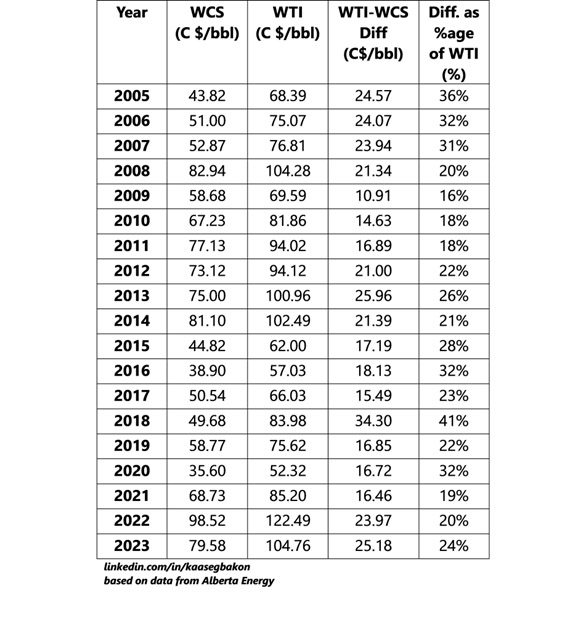
Our further analysis, which we do not show here, reveals that the discount exhibits seasonal variations and tends to be positively correlated with the price level of WTI. For more details on oil sands in Alberta, you may check out these resources provided by Anna Giove of OilSands Magazine.
- 0110 SaskEnergy SEI_Network_Members_Burn_Brighter0110 SaskEnergy SEI_Network_Members_Burn_Brighter
- 0109 SaskPower SASPO_2817_PLT_Recruitment_DIVERSITY0109 SaskPower SASPO_2817_PLT_Recruitment_DIVERSITY
- 0106 SASPO-2874_Self Serve Campaign_New Connects_Youtube_v30106 SASPO-2874_Self Serve Campaign_New Connects_Youtube_v3
- 0105 SaskEnergy Commitment to Safety0105 SaskEnergy Commitment to Safety
- 0102 Lori Carr Coal Extended0102 Lori Carr Coal Extended
- 0100 Turnbull Project Manager0100 Turnbull Project Manager
- 0099 Mryglod Steel 1080p0099 Mryglod Steel 1080p
- 0097 Eagle Sky Ventures LTD0097 Eagle Sky Ventures LTD
- 0095 Fast Trucking nearly 70 years good at it0095 Fast Trucking nearly 70 years good at it
- 0092 Turnbull projects big and small0092 Turnbull projects big and small
- 0046 City of Estevan This is Estevan Teaser0046 City of Estevan This is Estevan Teaser
- 0077 Caprice Resources Stand Up For Free Speech0077 Caprice Resources Stand Up For Free Speech
- 0061 SIMSA 2024 For Sask Buy Sask0061 SIMSA 2024 For Sask Buy Sask
- 0051 JML Hiring Pumpjack assembly0051 JML Hiring Pumpjack assembly
- 0049 Scotsburn Dental soft guitar0049 Scotsburn Dental soft guitar
- 0041 DEEP Since 2018 now we are going to build0041 DEEP Since 2018 now we are going to build
- 0032 IWS Summer hiring rock trailer music
- 0022 Grimes winter hiring
- 0021 OSY Rentals S8 Promo
- 0018 IWS Hiring Royal Summer
- 0013 Panther Drilling PO ad 03 top drive rigs
- 0002 gilliss casing services0002 gilliss casing services
- 9002 Pipeline Online 30 sec EBEX9002 Pipeline Online 30 sec EBEX
- 9001
ALBERTA’S OIL PRODUCTION
Oil produced from Alberta is classified broadly into conventional light oil, conventional heavy oil, upgraded and non-upgraded bitumen, and condensate. Alberta’s total oil production has grown at a Compound Annual Growth Rate (CAGR) of 2.43% per annum since the year 2000 from 1.5 MMbbls/day to 4.11 MMbbls/day in 2023.
However, this growth has been fueled by bitumen production – In 2000, bitumen (upgraded and non-upgraded) contributed 41% to total production, which had risen to 79% in 2023. Figure 1 illustrates.

Figure 1: Trend and Composition of Alberta’s Oil Production (2000 – 2023)
Meanwhile, conventional oil (light and heavy) declined from making up 50% of the production in the year 2000 to 13% in 2023. Condensate production has largely remained between 5% and 10% of Alberta’s total production since 2000.
- 0110 SaskEnergy SEI_Network_Members_Burn_Brighter0110 SaskEnergy SEI_Network_Members_Burn_Brighter
- 0109 SaskPower SASPO_2817_PLT_Recruitment_DIVERSITY0109 SaskPower SASPO_2817_PLT_Recruitment_DIVERSITY
- 0106 SASPO-2874_Self Serve Campaign_New Connects_Youtube_v30106 SASPO-2874_Self Serve Campaign_New Connects_Youtube_v3
- 0105 SaskEnergy Commitment to Safety0105 SaskEnergy Commitment to Safety
- 0102 Lori Carr Coal Extended0102 Lori Carr Coal Extended
- 0100 Turnbull Project Manager0100 Turnbull Project Manager
- 0099 Mryglod Steel 1080p0099 Mryglod Steel 1080p
- 0097 Eagle Sky Ventures LTD0097 Eagle Sky Ventures LTD
- 0095 Fast Trucking nearly 70 years good at it0095 Fast Trucking nearly 70 years good at it
- 0092 Turnbull projects big and small0092 Turnbull projects big and small
- 0046 City of Estevan This is Estevan Teaser0046 City of Estevan This is Estevan Teaser
- 0077 Caprice Resources Stand Up For Free Speech0077 Caprice Resources Stand Up For Free Speech
- 0061 SIMSA 2024 For Sask Buy Sask0061 SIMSA 2024 For Sask Buy Sask
- 0051 JML Hiring Pumpjack assembly0051 JML Hiring Pumpjack assembly
- 0049 Scotsburn Dental soft guitar0049 Scotsburn Dental soft guitar
- 0041 DEEP Since 2018 now we are going to build0041 DEEP Since 2018 now we are going to build
- 0032 IWS Summer hiring rock trailer music
- 0022 Grimes winter hiring
- 0021 OSY Rentals S8 Promo
- 0018 IWS Hiring Royal Summer
- 0013 Panther Drilling PO ad 03 top drive rigs
- 0002 gilliss casing services0002 gilliss casing services
- 9002 Pipeline Online 30 sec EBEX9002 Pipeline Online 30 sec EBEX
- 9001
REVENUE TO ALBERTA
In 2023, Alberta raked in C$19.3 billion in non-renewable resource revenue (NRR). This represented 26% of the total revenue to the province. The non-renewable resource revenue had climbed from C$ 3.09 billion 2020 to peak at C$ 25.24 billion in 2022.
Since year 2000, NRR has contributed anywhere between 7% to 40% of total revenue receipts to the government of Alberta.
Non-renewable revenue is comprised of:
- Natural Gas & By-product Royalty
- Conventional Oil Royalty
- Oil Sands Royalty
- Coal Royalty
- Bonuses & Sales of Crown Leases
- Rentals & Fees
In 2023, 90% of NRR was from oil royalty (conventional and oil sands). However, this hasn’t always been the case as illustrated by Figure 2.
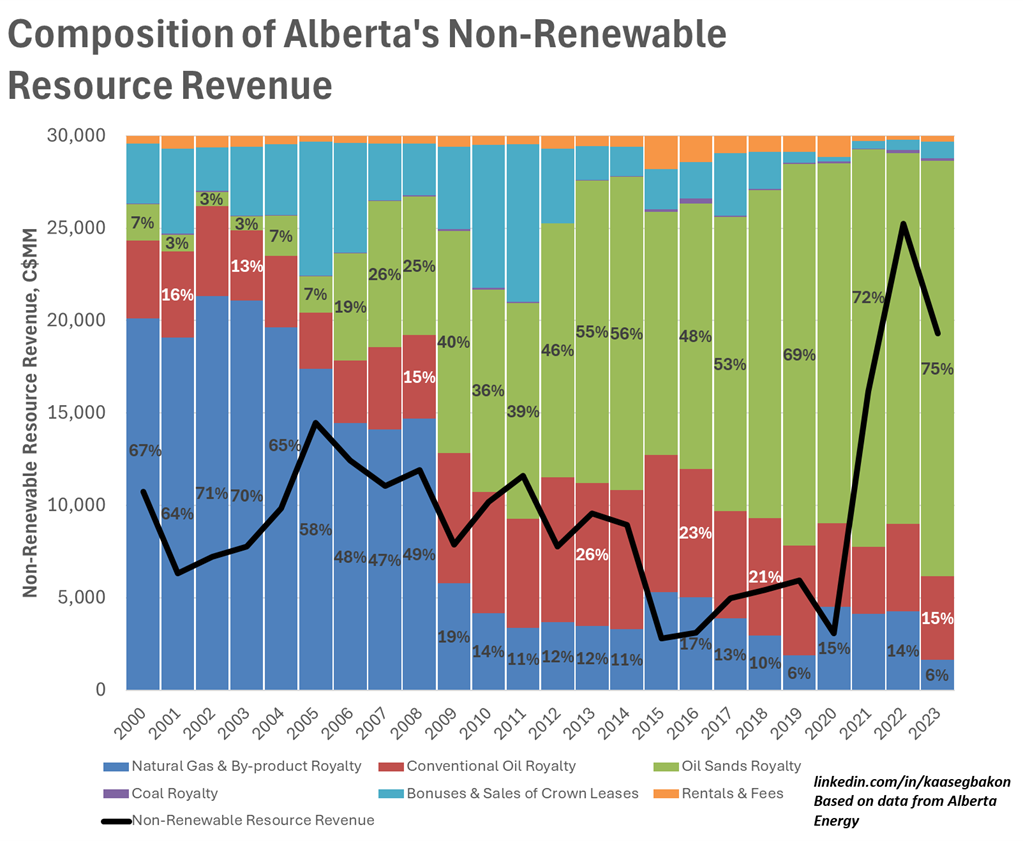
Figure 2: Trend and Composition of Alberta’s Non-Renewable Resource Revenue Receipts (2000 – 2023)
In 2000, oil sands royalty made up 7% of the NRR, and this had dramatically increased through the years to 75% in 2023. Conventional oil royalty contributed 16% in 2000, which increased to 26% in 2013, and by 2023 the contribution of conventional oil royalty to NRR had declined to 15%. You will notice that between 2005 and 2020, royalty from oil sands contributed an increasing share of declining NRR. In 2005, C$14.46 billion flowed to government coffers from the NRR, which had reduced to C$3.09 billion by 2020.
While the contribution of royalty from oil sands to NRR has become more significant over time, the natural gas and by-product royalty has seen decline from 67% in 2000 to 19% in 2009.
So, how is the royalty on oil sands determined?
- 0110 SaskEnergy SEI_Network_Members_Burn_Brighter0110 SaskEnergy SEI_Network_Members_Burn_Brighter
- 0109 SaskPower SASPO_2817_PLT_Recruitment_DIVERSITY0109 SaskPower SASPO_2817_PLT_Recruitment_DIVERSITY
- 0106 SASPO-2874_Self Serve Campaign_New Connects_Youtube_v30106 SASPO-2874_Self Serve Campaign_New Connects_Youtube_v3
- 0105 SaskEnergy Commitment to Safety0105 SaskEnergy Commitment to Safety
- 0102 Lori Carr Coal Extended0102 Lori Carr Coal Extended
- 0100 Turnbull Project Manager0100 Turnbull Project Manager
- 0099 Mryglod Steel 1080p0099 Mryglod Steel 1080p
- 0097 Eagle Sky Ventures LTD0097 Eagle Sky Ventures LTD
- 0095 Fast Trucking nearly 70 years good at it0095 Fast Trucking nearly 70 years good at it
- 0092 Turnbull projects big and small0092 Turnbull projects big and small
- 0046 City of Estevan This is Estevan Teaser0046 City of Estevan This is Estevan Teaser
- 0077 Caprice Resources Stand Up For Free Speech0077 Caprice Resources Stand Up For Free Speech
- 0061 SIMSA 2024 For Sask Buy Sask0061 SIMSA 2024 For Sask Buy Sask
- 0051 JML Hiring Pumpjack assembly0051 JML Hiring Pumpjack assembly
- 0049 Scotsburn Dental soft guitar0049 Scotsburn Dental soft guitar
- 0041 DEEP Since 2018 now we are going to build0041 DEEP Since 2018 now we are going to build
- 0032 IWS Summer hiring rock trailer music
- 0022 Grimes winter hiring
- 0021 OSY Rentals S8 Promo
- 0018 IWS Hiring Royal Summer
- 0013 Panther Drilling PO ad 03 top drive rigs
- 0002 gilliss casing services0002 gilliss casing services
- 9002 Pipeline Online 30 sec EBEX9002 Pipeline Online 30 sec EBEX
- 9001
Alberta’s Fiscal System: Driver of Oil Royalty Revenue
Alberta’s oil fiscal system contains provisions specific to conventional oil production as well as oil sands production. The system relies on a “revenue minus cost (R-C) principle” which implies that operators pay royalties based on revenues less costs. Regulations define the kinds of costs that are allowed for deductions for royalty calculations.
The R-C system is a two-stage structure.
- An initial “pre-payout” stage, during which operators recover costs. This stage is characterized by lower royalty rates than the next stage.
- The “post-payout” stage is triggered once a company has recovered its investments. Here the royalty rates are higher than the “pre-payout”.
For oil sands projects, the royalty rates are determined on a sliding scale, linked to WTI prices in Canadian dollars. However, the revenue which forms the basis for the royalty amount received by Alberta is determined by the WCS price. The graphic from the Alberta Treasury Board is helpful at this point.
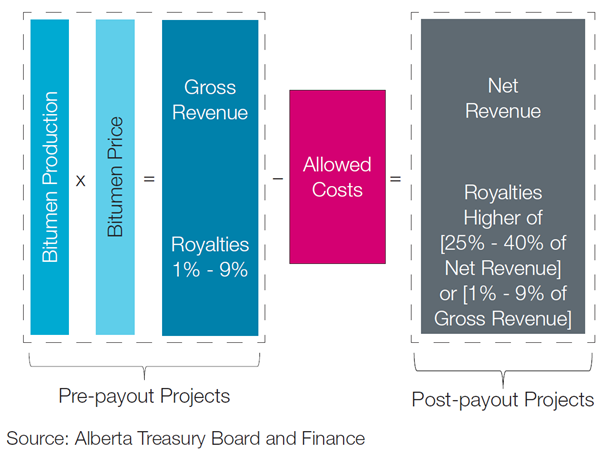
Figure 3: Schematic showing how Oil Sands Royalty is Computed (Alberta Treasury Board)
The “Bitumen price” referred to in the graphic is the price received by companies and forms the revenue for calculating royalties to the province. This “Bitumen Price” in the graphic (aka “Bitumen Netback)” is obtained by deducting transportation costs from the WCS price.
So, what has all this to do with the TMX and increased value to the treasury?
Well, if WCS prices can rise relative to WTI (shrinking the discount), due to the market access afforded by the TMX, then we can expect that more royalty revenue can be captured by the province.
But how much more? Stay with me!
- 0110 SaskEnergy SEI_Network_Members_Burn_Brighter0110 SaskEnergy SEI_Network_Members_Burn_Brighter
- 0109 SaskPower SASPO_2817_PLT_Recruitment_DIVERSITY0109 SaskPower SASPO_2817_PLT_Recruitment_DIVERSITY
- 0106 SASPO-2874_Self Serve Campaign_New Connects_Youtube_v30106 SASPO-2874_Self Serve Campaign_New Connects_Youtube_v3
- 0105 SaskEnergy Commitment to Safety0105 SaskEnergy Commitment to Safety
- 0102 Lori Carr Coal Extended0102 Lori Carr Coal Extended
- 0100 Turnbull Project Manager0100 Turnbull Project Manager
- 0099 Mryglod Steel 1080p0099 Mryglod Steel 1080p
- 0097 Eagle Sky Ventures LTD0097 Eagle Sky Ventures LTD
- 0095 Fast Trucking nearly 70 years good at it0095 Fast Trucking nearly 70 years good at it
- 0092 Turnbull projects big and small0092 Turnbull projects big and small
- 0046 City of Estevan This is Estevan Teaser0046 City of Estevan This is Estevan Teaser
- 0077 Caprice Resources Stand Up For Free Speech0077 Caprice Resources Stand Up For Free Speech
- 0061 SIMSA 2024 For Sask Buy Sask0061 SIMSA 2024 For Sask Buy Sask
- 0051 JML Hiring Pumpjack assembly0051 JML Hiring Pumpjack assembly
- 0049 Scotsburn Dental soft guitar0049 Scotsburn Dental soft guitar
- 0041 DEEP Since 2018 now we are going to build0041 DEEP Since 2018 now we are going to build
- 0032 IWS Summer hiring rock trailer music
- 0022 Grimes winter hiring
- 0021 OSY Rentals S8 Promo
- 0018 IWS Hiring Royal Summer
- 0013 Panther Drilling PO ad 03 top drive rigs
- 0002 gilliss casing services0002 gilliss casing services
- 9002 Pipeline Online 30 sec EBEX9002 Pipeline Online 30 sec EBEX
- 9001
HOW MUCH MORE CAN ALBERTA EXPECT FROM A NARROWER WTI-WCS DIFFERENTIAL
I should start with the caveat that this sort of question is best answered by a simulation model of Alberta’s fiscal system.
However, all is not lost. Figure 4 is a scatterplot of Alberta’s year-on-year change in oil royalty revenue versus the year-on-year change in WCS prices. Remember that it is the oil royalty revenue that is expected to be impacted by improved WCS prices.
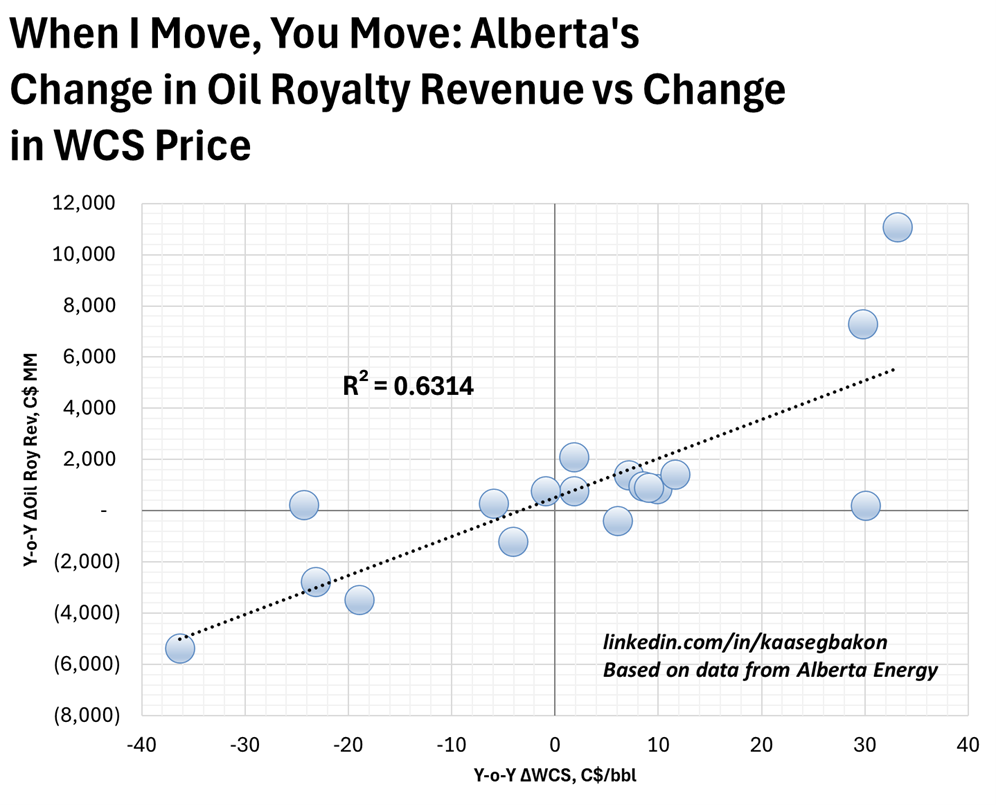
Figure 4: Scatterplot showing Change in Oil Royalty Revenue with Change in WCS price
The data points used span from 2005 to 2023 and include some periods of big changes in the royalty receipts due to the underlying mechanics of the government’s royalty rules. Just so you know.
Figure 4 implies that an increase in WCS relative to WTI prices (shrinking of the discount) is accompanied by increase in oil royalty revenue. Table 2 below provides some hard data points from our model.
| Increase of WCS price wrt WTI (C$/bbl) | Increase in AB oil royalty revenue (C$ MM) |
| 1 | 681 |
| 2 | 833 |
| 3 | 985 |
| 4 | 1,138 |
| 5 | 1,290 |
| linkedin.com/in/kaasegbakon | |
Table 2: Impact of WCS Price Increase on Oil Royalty Revenue
So, if the price of WCS could increase by $1/bbl (or the discount to WTI shrink by $1/bbl) because of the TMX, then Alberta oil royalty revenue could go up by C$680 million all else equal. If the TMX delivered $5/bbl more on top of the WCS price, then we are talking oil royalty revenues up by C$1.29 billion to the province.
Not bad.
However, be warned that if production out of the province keeps growing at the historic 2.43% per annum, pipeline capacity may reach full utilization soon and wipe out any WCS price gains. Let’s not let that happen.
- 0110 SaskEnergy SEI_Network_Members_Burn_Brighter0110 SaskEnergy SEI_Network_Members_Burn_Brighter
- 0109 SaskPower SASPO_2817_PLT_Recruitment_DIVERSITY0109 SaskPower SASPO_2817_PLT_Recruitment_DIVERSITY
- 0106 SASPO-2874_Self Serve Campaign_New Connects_Youtube_v30106 SASPO-2874_Self Serve Campaign_New Connects_Youtube_v3
- 0105 SaskEnergy Commitment to Safety0105 SaskEnergy Commitment to Safety
- 0102 Lori Carr Coal Extended0102 Lori Carr Coal Extended
- 0100 Turnbull Project Manager0100 Turnbull Project Manager
- 0099 Mryglod Steel 1080p0099 Mryglod Steel 1080p
- 0097 Eagle Sky Ventures LTD0097 Eagle Sky Ventures LTD
- 0095 Fast Trucking nearly 70 years good at it0095 Fast Trucking nearly 70 years good at it
- 0092 Turnbull projects big and small0092 Turnbull projects big and small
- 0046 City of Estevan This is Estevan Teaser0046 City of Estevan This is Estevan Teaser
- 0077 Caprice Resources Stand Up For Free Speech0077 Caprice Resources Stand Up For Free Speech
- 0061 SIMSA 2024 For Sask Buy Sask0061 SIMSA 2024 For Sask Buy Sask
- 0051 JML Hiring Pumpjack assembly0051 JML Hiring Pumpjack assembly
- 0049 Scotsburn Dental soft guitar0049 Scotsburn Dental soft guitar
- 0041 DEEP Since 2018 now we are going to build0041 DEEP Since 2018 now we are going to build
- 0032 IWS Summer hiring rock trailer music
- 0022 Grimes winter hiring
- 0021 OSY Rentals S8 Promo
- 0018 IWS Hiring Royal Summer
- 0013 Panther Drilling PO ad 03 top drive rigs
- 0002 gilliss casing services0002 gilliss casing services
- 9002 Pipeline Online 30 sec EBEX9002 Pipeline Online 30 sec EBEX
- 9001
